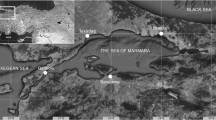Abstract
Several polychlorinated biphenyls (PCBs) and organochlorine pesticides (OCPs) investigated in soft tissues of the frequently monitored Mytilus galloprovincialis were compared to those of Ensis siliqua, a highly dispersed and economically important bivalve species, though rarely investigated. Overall PCBs had higher concentrations than OCPs in both species with a prevalence of tri- tetra-and penta-chlorinated biphenyls in E. siliqua and a prevalence of hexa- hepta and octa-chlorinated biphenyls in M. galloprovincialis. E. siliqua emerges as a suitable complement to mussels for monitoring PCBs and OCPs pollution.

Similar content being viewed by others
References
Ailstock MS, Hornor SG, Norman CM, Davids EM (2002) Resuspension of sediments by watercraft operated in shallow water habitats of Anne Arundel country, Maryland. J Coast Res 37:7–18
Bellas J, González-Quijano A, Vaamonde A, Fumega J, Soriano JA, González JJ (2011) PCBs in wild mussels (Mytilus galloprovincialis) from the N-NW Spanish coast: current levels and long-term trends during the period 1991-2009. Chemosphere 85(3):533–541
Carro N, García I, Ignacio M, Mouteira A (2012) Organochlorine pesticide levels in Ensis siliqua (Linnaeus, 1758) from Ría de Vigo, Galicia (N.W. Spain): influence of season, condition index and lipid content. Bull Environ Contam Toxicol 88(4):491–496
Carvalho FP, Villeneuve JP, Cattini C, Rendón J, de Oliveira JM (2009) Ecological risk assessment of PCBs and other organic contaminant residues in Laguna de Terminos, Mexico. Ecotoxicology 18(4):403–416
Di Muccio A, Stefanelli P, Funari E, Barbini DA, Generali T, Pelosi P, Girolimetti S, Amendola G, Vanni F, Di Muccio S (2002) Organochlorine pesticides and polychlorinated biphenyls in 12 edible marine organism from the Adriatic Sea, Italy, spring 1997. Food Addit Contam 19(12):1148–1161
El-Shahawi MS, Hamza A, Bashammakh AS, Al-Saggaf WT (2010) An overview on the accumulation, distribution, transformations, toxicity and analytical methods for the monitoring of persistent organic pollutants. Talanta 80(5):1587–1597
Fahy E, Gaffney J (2001) Growth statistics of an exploited razor clam (Ensis siliqua) bed at Gormanstown, Co., Meath, Ireland. Hydrobiologia 465:139–151
Ferrante MC, Cirillo T, Naso B, Clausi MT, Lucisano A, Amodio Cocchieri R (2007) Polychlorinated biphenyls and organochlorine pesticides in seafood from the Gulf of Naples (Italy). J Food Prot 70(3):706–715
Ferrante MC, Clausi MT, Meli R, Fusco G, Naccari C, Lucisano A (2010) Polychlorinated biphenyls and organochlorine pesticides in European eel (Anguilla anguilla) from the Garigliano River (Campania region, Italy). Chemosphere 78(6):709–716
Freire R, Fernández-Tajes J, Méndez J (2008) Identification of razor clams Ensis arcuatus and Ensis siliqua by PCR-RFLP analysis of ITS1 region. Fish Sci 74(3):511–515
Hawker DW, Connell DW (1988) Octanol-water partition coefficients of polychlorinated biphenyl congeners. Environ Sci Technol 22(4):382–387
Iwata H, Tanabe S, Ueda K, Tatsukawa R (1995) Persistent organochlorine residues in air, water, sediments, and soils from the lake baikal region, Russia. Environ Sci Technol 29(3):792–801
Kljaković-Gaspić Z, Herceg-Romanić S, Kozul D, Veza J (2010) Biomonitoring of organochlorine compounds and trace metals along the Eastern Adriatic coast (Croatia) using Mytilus galloprovincialis. Mar Pollut Bull 60(10):1879–1889
Piérard C, Garrigues P (1996) Grain-size distribution of polychlorobiphenyls in coastal sediments. Environ Sci Technol 30(9):2776–2778
Sheehan D, McIntosh J, Power A, Fitzpatrick PJ (1995) Drug metabolizing enzymes of mussels as bioindicators of chemical pollution. Biochem Soc Trans 23(2):419–422
Suntio RL, Shiu WY, Mackay D, Seiber JN, Glotfelty G (1988) Critical review of Henry’s law constants for pesticides. Rev Environ Contam T 103:1–59
Thompson S, Budzinski H, Garrigues P, Narbonne JF (1999) Comparison of PCB and DDT distribution between water-column and sediment-dwelling bivalves in Arcachon Bay, France. Mar Pollut Bull 38(8):655–662
Wootton EC, Dyrynda EA, Ratcliffe NA (2003) Bivalve immunity: comparisons between the marine mussel (Mytilus edulis), the edible cockle (Cerastoderma edule) and the razor-shell (Ensis siliqua). Fish Shellfish Immunol 15:195–210
Acknowledgments
During this study, Anna Santoro has benefited from a Ph.D. fellowship provided by the Province of Naples (Department of Environment; Project number 4/Bil.2010).
Author information
Authors and Affiliations
Corresponding author
Appendix
Rights and permissions
About this article
Cite this article
Ferrante, M.C., Clausi, M.T., Naccari, C. et al. Does the Clam Ensis siliqua Provide Useful Information About Contamination by Polychlorinated Biphenyls and Organochlorine Pesticides Beyond that of Mussel Mytilus galloprovincialis?. Bull Environ Contam Toxicol 92, 636–641 (2014). https://doi.org/10.1007/s00128-014-1259-9
Received:
Accepted:
Published:
Issue Date:
DOI: https://doi.org/10.1007/s00128-014-1259-9




